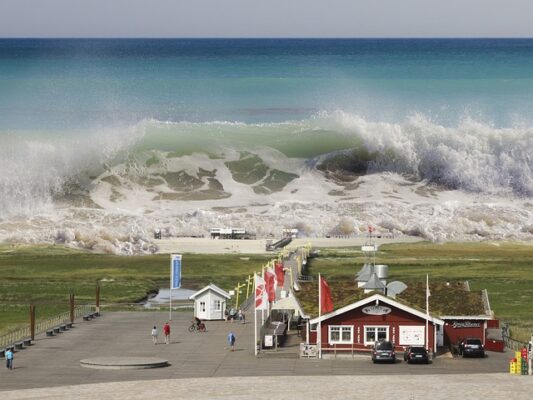Tsunami is a series of gigantic waves that are caused due to the underwater earthquake. It so happens that the earthquake under water pushes the water upward because the plates collide with each other and as it turns out the wave gets bigger and bigger and travel at a high speed. Unlike regular waves, tsunami waves are completely unbreakable with longer wavelengths. It has to take place under water in order to qualify as tsunami and the magnitude must be greater than 6.75 on Richter scale. Tsunamis for most part take place in the Pacific Ocean and coastal areas.
Tsunami Facts for Kids
Is it possible to Detect Tsunami before it hits?
With the advancement in modern technology one would expect that it’s possible but still it is extremely difficult to detect the coming of huge death waves until when it comes. Do not forget that even a simple earthquake is least likely to be detected even though devices like seismographs are used to serve the purpose.
What does Tsunami Mean?
Tsunami is a Japanese word which means “harbor wave”. These are not merely tidal waves that are caused by the gravitational force of the moon. You can say that it is an abnormal behavior of waves rising above 100 feet.
How High the Tsunami is?
The height of the waves caused by tsunami goes up to 100 feet but the average height is rarely above 40 to 50 feet as it depends on how shallow the water is. Under shallow waters, the height is greater.
At what Speed Tsunami waves move?
 The tsunami moves at the speed of 200 to 600 miles per hour at the deepest point of water. However, their speed is much lesser as they approach near the shore (30 – 40 mph). The waves in the shallow water travels at much lesser speed but the height is greater than deep water waves.
The tsunami moves at the speed of 200 to 600 miles per hour at the deepest point of water. However, their speed is much lesser as they approach near the shore (30 – 40 mph). The waves in the shallow water travels at much lesser speed but the height is greater than deep water waves.
Which country suffered the most?
Japan is the only country that is hit (by tsunami) as many times as no other country.
What do Tsunami waves look like?
These are not like regular waves which are breakable or perhaps curled over one another. In fact tsunami is a gigantic wave of water that looks like a big wall constantly rising like a flood.
How Tsunami forms?
An earthquake under water forces the water to rise upward. As it turns out the waves created by the push travel fast to the coast and on the way they become bigger. Finally on reaching the shore, these gigantic waves smash against the coast and flood the land.
Which Country is at a Greatest risk for Tsunami?
Hawaii is most likely to be under the greatest threat of tsunami than any other country. Often do they come across once a year though the intensity is not so great.
When did the First Tsunami take place and how many people killed?
The first tsunami had occurred way back in Nov. 1, 1755 in the waters of Portugal and it claimed 60,000 lives.
When was the Deadliest Tsunami occurred?
The deadliest tsunami occurred in the human history was in December 26, 2004 as it killed 227,898 people. The magnitude of the earthquake recorded at 9.1 on Richter scale. It hit many countries in South Asia and East Africa including 14 countries with Sumatra and Indonesia on the forefront.
When was the most Recent Tsunami?
It was in the coast of Japan on March 11, 2011 with the magnitude of 9.0 killing 15,880 people on its way.
What makes Tsunami different from Regular waves?
Tsunami is quite from regular waves in that it has very long wavelengths that can run up to hundreds of kilometers; whereas regular waves have wavelengths of 30 to 40 meters only. It is because of this reason that tsunamis create a great impact causing a greater damage.
Regular waves are the combinations of many waves but tsunami is a single wave that is absolutely unbreakable.
The height of tsunami is not so great as they reach up to 100 feet but still it is bigger than the regular waves’ amplitude of 300 millimeters. The height of the wave is primarily determined by the distance between the floor from the surface of water; the lesser the distance the greater the height.
Leave a Reply